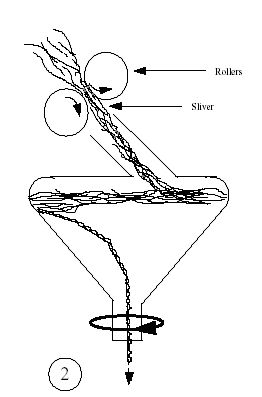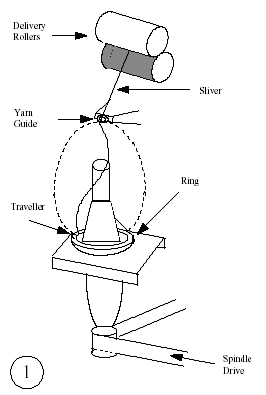
The fibers are now spun together into either spun yarns or filament yarns. Filament yarns are made from continuous fine strands of
man-made fiber (e.g. not staple-length fibers). Spun yarns are composed of overlapping staple-length fibers that are bound together by twist. Methods
used to produce spun yarns, rather than filament yarns, are discussed in this section. The rovings produced in the drafting step are mounted onto the spinning frame, where they are set for spinning. The yarn is first fed through another set of drawing or delivery rollers, which lengthen and stretch it still further. It is then fed onto a high-speed spindle by a yarn guide that travels up and down the spindle. The difference in speed of travel between the guide and the spindle determines the amount of twist imparted to the yarn. The yarn is collected on a bobbin.
 In ring spinning,
(see picture to the left) the sliver is fed from delivery rollers through a traveler, or wire loop, located on a ring. The rotation of the spindle around the ring adds twist to the yarn. Another method is open-end
spinning (see picture to the right), which accounts for more than 50 percent of spinning equipment used
(ATMI, 1997b). In this method, sliver passes through rollers into a rotating funnel-shaped rotor. The sliver hits the inside of the rotor and rebounds to the left side of the rotor, causing the sliver to twist. Open-end spinning does not use rotating spindles since the yarn is twisted during passage through the rotor.
In ring spinning,
(see picture to the left) the sliver is fed from delivery rollers through a traveler, or wire loop, located on a ring. The rotation of the spindle around the ring adds twist to the yarn. Another method is open-end
spinning (see picture to the right), which accounts for more than 50 percent of spinning equipment used
(ATMI, 1997b). In this method, sliver passes through rollers into a rotating funnel-shaped rotor. The sliver hits the inside of the rotor and rebounds to the left side of the rotor, causing the sliver to twist. Open-end spinning does not use rotating spindles since the yarn is twisted during passage through the rotor.
Yarn spinning is basically an extension of the preparation steps described above for natural fibers. Additional twisting of the yarn may occur, or multiple yarns may be twisted together to form plied yarns. Plying takes place on a machine similar to a spinning frame. Two or more yarns pass
through a pair of rollers and onto a rotating spindle. The yarn guide positions the yarn onto the spindle and assists in applying twist. Plied yarns may be plied again to form thicker cords,
ropes and cables.